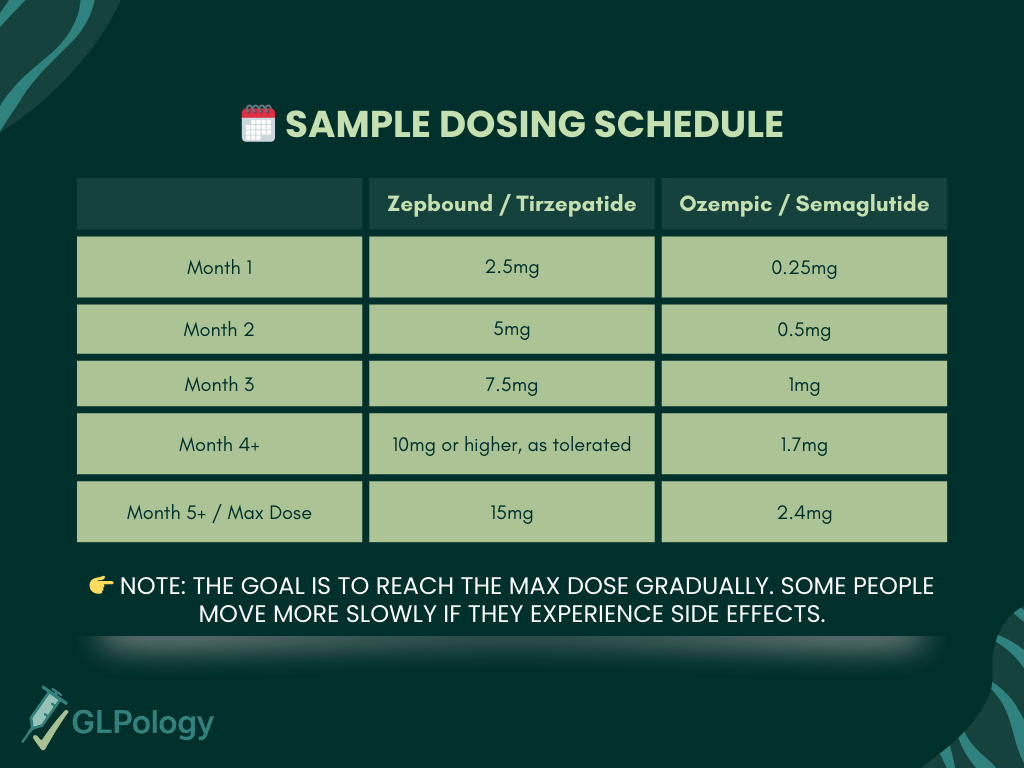GLP-1 Dosing: What to Know Before You Start
Starting a GLP-1 medication like Zepbound, Wegovy, or a compounded version can be life-changing—but dosing can be confusing at first. Whether you're using semaglutide or tirzepatide, the journey is designed to be gradual. That slow approach? It’s intentional. It helps your body adjust and reduces side effects.
Here’s what you need to know about dosing—before, during, and after your first shot.
💉 Why GLP-1 Dosing Is So Gradual
GLP-1 medications affect your appetite, digestion, and insulin sensitivity. They’re powerful. But that power comes with a need to ease in. Starting too high, too fast can lead to intense nausea, vomiting, or worse.
The goal of the initial doses is tolerability, not weight loss.

⚠️ What If You’re Using a Compounded Version?
Compounded semaglutide and tirzepatide follow the same dosing schedule as branded meds—but there’s a catch: the units or syringe volume will vary. Even between compounders.
This is where things can get dangerous if you're not careful.
Here’s what you need to ask:
-
What’s the concentration of the vial? (e.g., mg/mL)
-
How much volume (mL or units) equals the correct dose?
-
What syringe size should I use?
💡 A helpful resource: https://www.fatscientist.com/ has a free calculator that can help you translate your dose safely.
🔥 Getting this wrong can lead to overdosing or underdosing.
If you’re ever unsure, ask your provider or pharmacist to walk you through it—step by step.
🌀 Side Effects and When They Happen
The most common side effects happen right after a dose increase. That’s when nausea, fatigue, or constipation might spike.
Common side effects:
-
Nausea 🤢
-
Bloating
-
Constipation or diarrhea
-
Fatigue
-
Burping or heartburn
These usually pass within a few days as your body adjusts.
Pro tip: Prep easy-to-digest meals ahead of time before you increase your dose.
🧊 What If You Miss a Dose?
If you miss your weekly dose and it’s been less than 4 days, take it late.
If it’s been more than 4 days, skip it and resume your schedule next week.
Always check your medication’s specific guidance—and contact your provider if this happens often.
🧠 When to Stay at a Lower Dose
You don’t need to push through a tough dose increase. You can always:
-
Stay on your current dose longer
-
Go back to the previous dose
-
Try again later after managing side effects
Your journey is your own—and slower doesn't mean you’re failing.
✂️ What’s Split Dosing?
Split dosing means dividing your weekly GLP-1 dose into two smaller injections (e.g., taking half on Monday and half on Thursday). It’s not officially approved by manufacturers, but many patients report that it helps manage side effects like nausea, fatigue, and GI discomfort.
Why people try it:
-
Reduces the intensity of side effects
-
May smooth out energy dips or digestive symptoms
-
Especially common at higher doses or when titrating up
⚠️ Note: If you’re considering split dosing, talk to your provider.
🐢 Low and Slow vs. Standard Titration: What’s Better?
Our take?
There’s no one-size-fits-all path. Some people tolerate fast titration just fine. Others need extra time to adjust, especially if they have underlying GI conditions, are older, or are on other medications.
The key is to listen to your body and check in regularly with your prescriber.

📈 Final Thought: Dosing Isn’t a Race
GLP-1 dosing is meant to be gradual. It’s not a sprint to the highest dose. Whether you’re on Wegovy, Zepbound, or a compounded version, consistency and comfort matter more than speed.
Stay curious, stay informed—and know that GLPology is here to guide you every step of the way.

